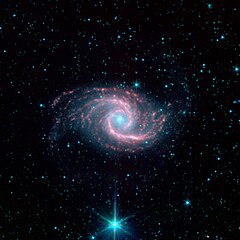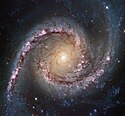NGC 1566
 Zdjęcie galaktyki w średniej podczerwieni wykonane przez Kosmiczny Teleskop Spitzera | |
| Odkrywca | |
|---|---|
| Data odkrycia | 28 maja 1826 |
| Dane obserwacyjne (J2000) | |
| Gwiazdozbiór | |
| Typ | spiralna z poprzeczką (SBbc) |
| Rektascensja | 04h 20m 00,5s |
| Deklinacja | –54° 56′ 14″ |
| Przesunięcie ku czerwieni | 0,005036[1] |
| Jasność obserwowana | 9,4m |
| Rozmiary kątowe | 8,2' × 6,5' |
| Alternatywne oznaczenia | |
| PGC 14897, ESO 157-20, IRAS04189-5503 | |
NGC 1566 (również Galaktyka Hiszpańska Tancerka[2] lub PGC 14897) – galaktyka spiralna z poprzeczką (SBbc), znajdująca się w gwiazdozbiorze Złotej Ryby. Odkrył ją James Dunlop 28 maja 1826 roku[3]. Należy do galaktyk Seyferta[1].

Oglądana przez niewielki teleskop ma kształt dwuramiennej spirali[2].
W galaktyce tej zaobserwowano supernową SN 2010el[4].
Zobacz też
Przypisy
- ↑ a b NGC 1566 w bazie SIMBAD (ang.)
- ↑ a b Praca zbiorowa: Kosmos. Warszawa: Buchmann Sp. z o.o., 2012, s. 368. ISBN 978-83-7670-323-7.
- ↑ Courtney Seligman: NGC 1566. Celestial Atlas. [dostęp 2015-02-02]. (ang.).
- ↑ List of Supernovae. [w:] IAU Central Bureau for Astronomical Telegrams [on-line]. Międzynarodowa Unia Astronomiczna. [dostęp 2015-02-02]. (ang.).
Linki zewnętrzne
- NGC 1566 w serwisie SEDS.org (Revised NGC and IC Catalog) (ang.)
- NGC 1566 w bazie SIMBAD (ang.)
- NGC 1566 w NASA/IPAC Extragalactic Database (ang.)
Media użyte na tej stronie
Autor: Credit: ESA/Hubble & NASA Acknowledgement: Det58, Licencja: CC BY 3.0
Grand swirls
This new Hubble image shows NGC 1566, a beautiful galaxy located approximately 40 million light-years away in the constellation of Dorado (The Dolphinfish). NGC 1566 is an intermediate spiral galaxy, meaning that while it does not have a well defined bar-shaped region of stars at its centre — like barred spirals — it is not quite an unbarred spiral either (heic9902o).
The small but extremely bright nucleus of NGC 1566 is clearly visible in this image, a telltale sign of its membership of the Seyfert class of galaxies. The centres of such galaxies are very active and luminous, emitting strong bursts of radiation and potentially harbouring supermassive black holes that are many millions of times the mass of the Sun.
NGC 1566 is not just any Seyfert galaxy; it is the second brightest Seyfert galaxy known. It is also the brightest and most dominant member of the Dorado Group, a loose concentration of galaxies that together comprise one of the richest galaxy groups of the southern hemisphere. This image highlights the beauty and awe-inspiring nature of this unique galaxy group, with NGC 1566 glittering and glowing, its bright nucleus framed by swirling and symmetrical lavender arms.
This image was taken by Hubble’s Wide Field Camera 3 (WFC3) in the near-infrared part of the spectrum. A version of the image was entered into the Hubble’s Hidden Treasures image processing competition by Flickr user Det58.
Credit:
ESA/Hubble & NASA
Acknowledgement: Flickr user Det58
About the Object
Name: NGC 1566
Type: • Local Universe : Galaxy : Type : Spiral
• Local Universe : Galaxy : Activity : AGN : Seyfert
• X - Galaxies Images/Videos
Distance: 40 million light years
Colours & filters Band Wavelength Telescope
Ultraviolet UV 275 nm Hubble Space Telescope WFC3 Ultraviolet U 336 nm Hubble Space Telescope WFC3 Optical B 438 nm Hubble Space Telescope WFC3 Optical V 555 nm Hubble Space Telescope WFC3 Infrared I 814 nm Hubble Space Telescope WFC3.
NGC 1566

